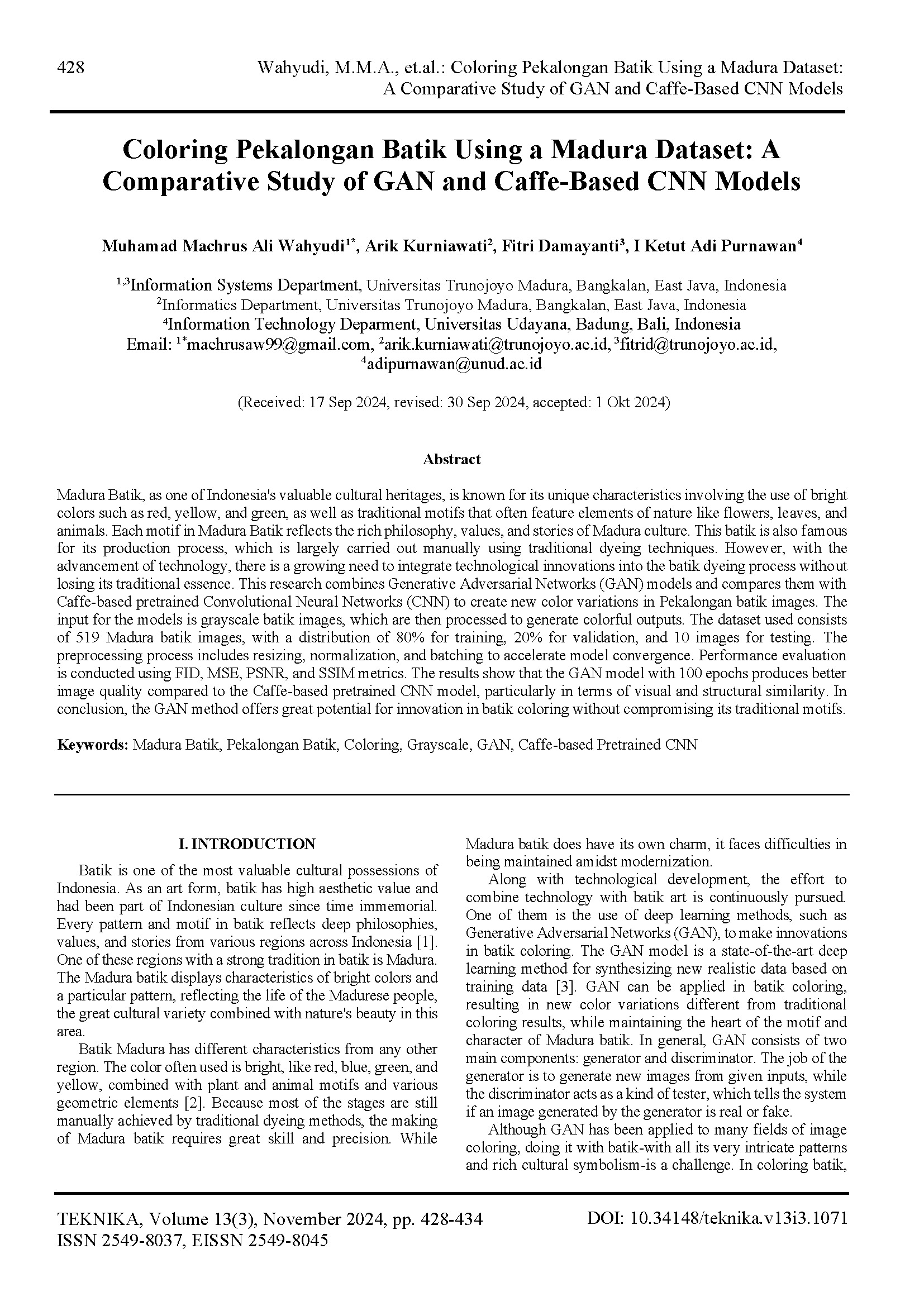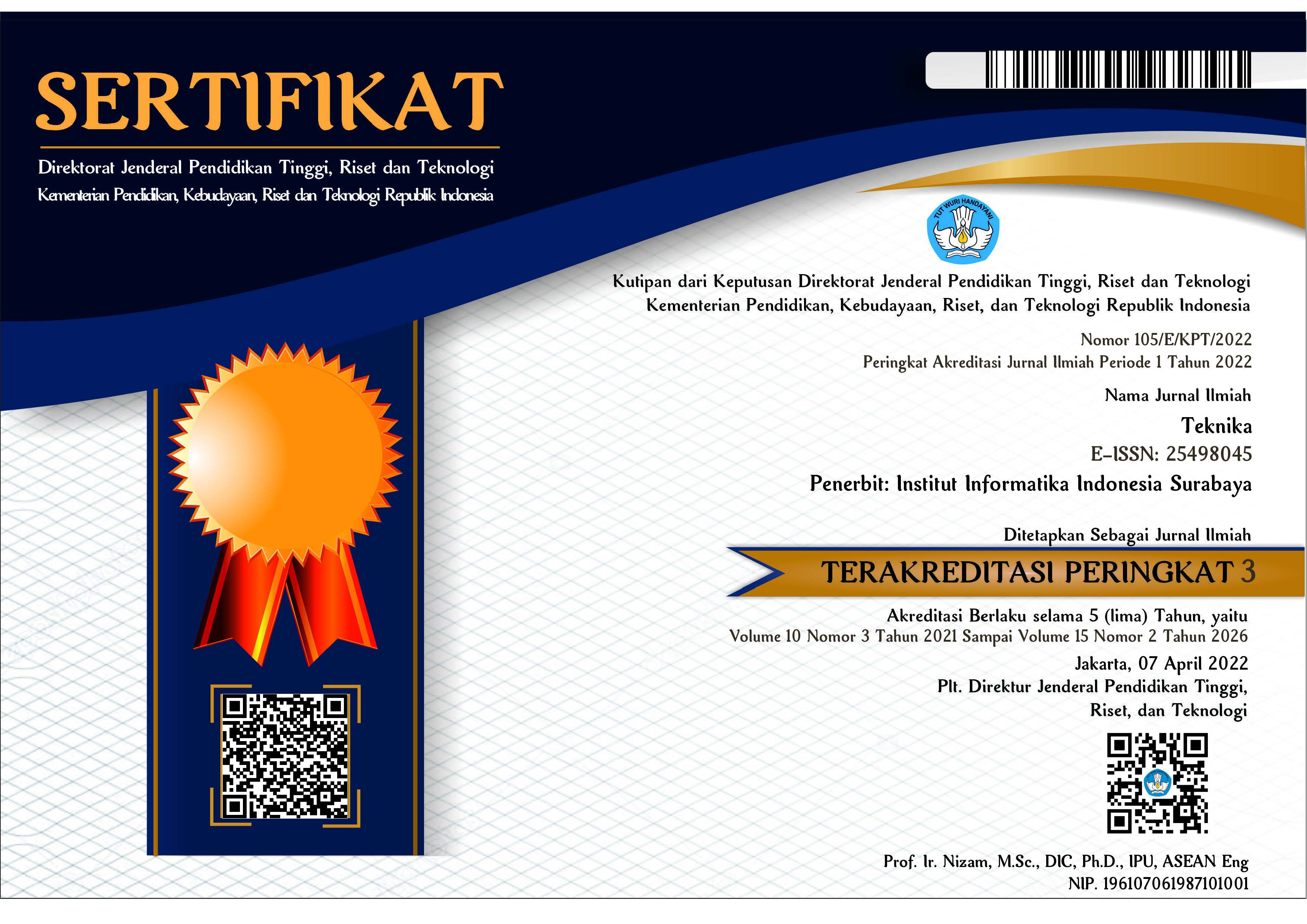Coloring Pekalongan Batik Using a Madura Dataset: A Comparative Study of GAN and Caffe-Based CNN Models
DOI:
https://doi.org/10.34148/teknika.v13i3.1071Keywords:
Madura Batik, Pekalongan Batik, Coloring, Grayscale, GAN, Caffe-based Pretrained CNNAbstract
Madura Batik, as one of Indonesia's valuable cultural heritages, is known for its unique characteristics involving the use of bright colors such as red, yellow, and green, as well as traditional motifs that often feature elements of nature like flowers, leaves, and animals. Each motif in Madura Batik reflects the rich philosophy, values, and stories of Madura culture. This batik is also famous for its production process, which is largely carried out manually using traditional dyeing techniques. However, with the advancement of technology, there is a growing need to integrate technological innovations into the batik dyeing process without losing its traditional essence. This research combines Generative Adversarial Networks (GAN) models and compares them with Caffe-based pretrained Convolutional Neural Networks (CNN) to create new color variations in Pekalongan batik images. The input for the models is grayscale batik images, which are then processed to generate colorful outputs. The dataset used consists of 519 Madura batik images, with a distribution of 80% for training, 20% for validation, and 10 images for testing. The preprocessing process includes resizing, normalization, and batching to accelerate model convergence. Performance evaluation is conducted using FID, MSE, PSNR, and SSIM metrics. The results show that the GAN model with 100 epochs produces better image quality compared to the Caffe-based pretrained CNN model, particularly in terms of visual and structural similarity. In conclusion, the GAN method offers great potential for innovation in batik coloring without compromising its traditional motifs.
Downloads
References
K. H. Suradiradja and K. Nano, “Perbandingan Model Deep Learning Untuk Prediksi Klasifikasi Jenis Batik,” InComTech J. Telekomun. dan Komput., vol. 14, no. 2, pp. 97–105, 2024.
L. Franca, J. Bahasa, dan Pengajaranya, E. Pebri Ila Rachma, and Q. Lailyn Amrullah, “Menduniakan Batik Tulis Madura Lewat Semiotika Motifbatik Yang Unik Dan Khas : Diplomasi Budaya,” Ling. Fr. J. Bahasa, Sastra, dan Pengajaranya, vol. 8, no. 1, pp. 11–25, 2024.
A. Satriawan, B. Imran, and S. Erniwati, “Identifikasi Kemiripan Foto Asli dan Sketsa Menggunakan Model Generatif Adversarial Network (GANs),” J. Kecerdasan Buatan dan Teknol. Inf., vol. 2, no. 3, pp. 122–127, 2023, doi: 10.69916/jkbti.v2i3.36.
Y. Al Najjar, “Comparative Analysis of Image Quality Assessment Metrics: MSE, PSNR, SSIM and FSIM,” Int. J. Sci. Res., vol. 13, no. 3, pp. 110–114, 2024, doi: 10.21275/sr24302013533.
R. R. Kalendesang and D. H. Setiabudi, “Pewarnaan Otomatis Sketsa Gambar Menggunakan Metode Conditional GAN Untuk Mempercepat Proses Pewarnaan,” J. Infra, vol. 10, no. 2, 2022.
Y. Jo and J. Park, “SC-FEGAN: Face editing generative adversarial network with user’s sketch and color,” Proc. IEEE Int. Conf. Comput. Vis., vol. 2019-Octob, pp. 1745–1753, 2019, doi: 10.1109/ICCV.2019.00183.
Sandi Indika Saputra, “Batik Madura Dataset,” Kaggle, 2024. https://www.kaggle.com/datasets/ndisan/batik-madura (accessed Aug. 06, 2024).
M. Ricky and M. E. Al Rivan, “Implementasi Deep Convolutional Generative Adversarial Network untuk Pewarnaan Citra Grayscale,” J. Tek. Inform. dan Sist. Inf., vol. 8, no. 3, pp. 556–566, 2022, doi: 10.28932/jutisi.v8i3.5218.
T. Tirtawan, E. K. Susanto, P. C. S. W. Lukman Zaman, and Y. Kristian, “Batik Clothes Auto-Fashion using Conditional Generative Adversarial Network and U-Net,” 3rd 2021 East Indones. Conf. Comput. Inf. Technol. EIConCIT 2021, pp. 145–150, 2021, doi: 10.1109/EIConCIT50028.2021.9431867.
N. T. Tran, T. A. Bui, and N. M. Cheung, “Dist-gan: An improved gan using distance constraints,” Lect. Notes Comput. Sci. (including Subser. Lect. Notes Artif. Intell. Lect. Notes Bioinformatics), vol. 11218 LNCS, pp. 387–401, 2018, doi: 10.1007/978-3-030-01264-9_23.
A. B. J. Malyan, R. R. Putra, E. Laila, A. T. Wardhana, M. Fikri, and I. G. T. Isa, Epoch Tuning Hyperparameter in Fire Image Classification at University Sjakhyakirti, vol. 1. Atlantis Press International BV, 2023. doi: 10.2991/978-94-6463-118-0_37.
I. Denata, T. Rismawan, and I. Ruslianto, “Implementation of Deep Learning for Classification Type of Orange Using The Method Convolutional Neural Network,” Telematika, vol. 18, no. 3, p. 297, 2021, doi: 10.31315/telematika.v18i3.5541.
S. Shaban, R. P. Singh, and D. M. Mehra, “Age and Gender Prediction using Caffe Model and OpenCV,” Int. J. Innov. Res. Comput. Sci. Technol., no. 1, pp. 15–21, 2022, doi: 10.55524/ijircst.2022.10.1.4.
D. Torbunov et al., “UVCGAN: UNet Vision Transformer cycle-consistent GAN for unpaired image-to-image translation,” Proc. - 2023 IEEE Winter Conf. Appl. Comput. Vision, WACV 2023, pp. 702–712, 2023, doi: 10.1109/WACV56688.2023.00077.























